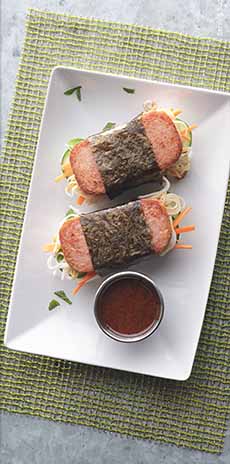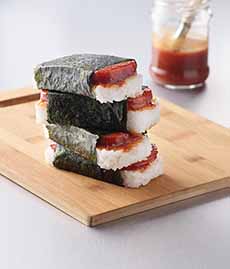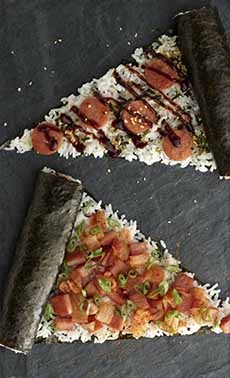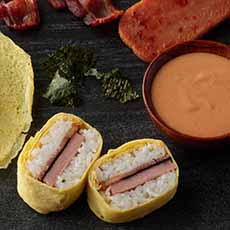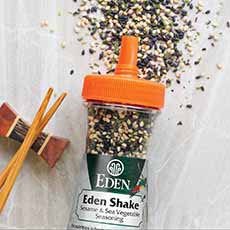SPAM Musubi Recipes For National Spam Musubi Day
|
|
You may know what SPAM luncheon meat is, but do you know SPAM Musubi? It’s when a slice of SPAM is served atop a pad of nigiri sushi rice. Yes, it’s SPAM sushi. And we’ve got SPAM Musubi recipes! August 8th is National SPAM Musubi Day, trailing July 31st, National SPAM Day. What is SPAM Musubi? It may look like SPAM sushi, but sushi requires vinegared rice and this rice has no vinegar. Instead, musubi is the same as onigiri, a Japanese rice ball (made in different shapes) that’s made with regular steamed rice, no vinegar. Meat, fish, or vegetables are tucked inside the rice. Both musubi and onigiri mean the same thing, with regional differences. Some Japanese speakers use one word, some use the other. Recipes follow, but first a bit of history as to how SPAM musubi came to be. > The history of SPAM. During World War II, many Pacific outposts had little refrigeration or local sources of meat. American and Allied troops were supplied with cans of SPAM, which were easily stored without refrigeration, required no cooking, and could be eaten on the go. Hormel says more than 100 million pounds of SPAM were shipped overseas on both fronts, to help feed the troops during the war. Not surprisingly, the troops got sick of it. Even the commander-in-chief. General Dwight D. Eisenhower, ate his share [source]. But after the war, residents of conflict-wracked countries struggled with hunger and famine, and cans of SPAM sent to them were sometimes the only protein source available. SPAM became integrated into local dishes. In the decades after World War II, as native Koreans and Japanese migrated to Hawaii, they brought their cuisines. Japanese immigrants to Hawaii are credited with inventing SPAM musubi, a SPAM version of a rice ball. Musubi uses SPAM instead of the fish or other ingredients used in a rice ball (musubi or onigiri). SPAM musubi has led to SPAM burritos and SPAM tacos. There are also SPAM banh mì, SPAM bibimbap, SPAM budae jjigae (Korean stew), SPAM corn dogs, SPAM fried rice, SPAM fries, SPAM poke bowls, SPAM ramen, and much more. Check out all of the official SPAM recipes. In Hawaii, where the U.S. military has long maintained a presence, more SPAM is consumed per person than in any other state. In addition to the original SPAM musubi recipe, below, the brand has created: You can make this with one or two rice layers. The rice is seasoned with furikake is a Japanese seasoning made from dried bonito, sesame seeds, nori seaweed flakes, sugar, salt, and MSG. You can find furikake in Asian food stores and online. Its name derives from the Japanese word for sprinkles. It’s commonly served on bowls of steamed rice. Prep time is 10 minutes and cook time is 5 minutes (plus rice cooking time). 1. COOK the SPAM in a large skillet until lightly browned and crisp. Drizzle with grill sauce or cooking sauce. 2. PLACE the rice into a musubi press. Or, line the inside of an empty SPAM can with plastic wrap and add the rice. Press the rice down firmly. 3. SPRINKLE the rice with seasoned furikake and toasted sesame seeds. Place the SPAM on top of the rice. Press down firmly. Optional: top with the remaining rice and press down. 4. REMOVE the layered SPAM and rice from the musubi press or can. On a work surface, cut the nori to the desired width. 5. LAY the nori shiny-side-down. Top with the layered SPAM and rice. Wrap the nori around it. Serve immediately. CHECK OUT WHAT’S HAPPENING ON OUR HOME PAGE, THENIBBLE.COM.
|
|
|
|
||

